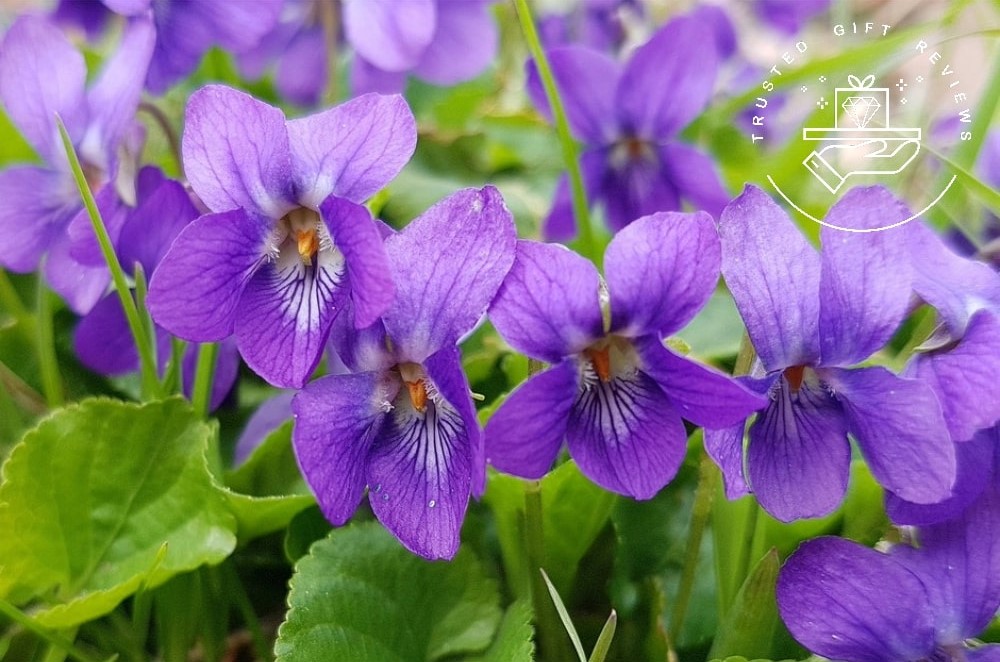Violet flowers hold a world of wonder within their purple-blue petals. They are a symbol of loyalty and purity and attract pollinators like hummingbirds and bees.
Whether you’re looking for the perfect addition to a floral arrangement or your garden, these blossoms will surely fascinate you!
In this article, we will discuss their meanings, origin, and how we can use them to add color to our lives!
How did the violet flower get its name?


The violet flower got its name from the Latin word “viola,” which simply means “purple.”
What are the botanical origins of the violet flower?


The violet flower is scientifically known as Viola, which is a genus of flowering plants in the Violaceae family. They are perennial plants, which means they can live for more than two years.
They have leaves that look like hearts and flowers that come in various colors, such as purple, lavender, yellow, and white.
Most violet flowers are found in places with temperate climates in the Northern Hemisphere. However, some grow in other areas such as Hawaii and Australia.
Where do violet flowers grow?
Violet flowers are commonly seen in woodland gardens, on rocky slopes, along river banks, or beneath shrubs with a little shade.
Do violet flowers require a lot of maintenance?
Violet flowers are low-maintenance plants. Just be sure not to overwater them to prevent root rot.
To promote continuous blooming, remove the old wilted flowers regularly.
Do violet flowers need shade or sun?
Violet flowers need full sun or partial shade.
When do violet flowers bloom?
The blooming period of violet flowers varies depending on the species and their location. However, in general, violet flowers tend to bloom in the spring.
What kind of soil do violet flowers prefer?
Violet flowers do best in soil that is moist, well-drained, and rich in organic matter. They thrive in a slightly acidic to neutral pH soil level.
When is the best time to plant violet flower seeds?
Most violet species are best planted in late summer or early fall.
What do violet flowers mean?


Violet flowers symbolize innocence, spiritual wisdom, faithfulness, eternal love, modesty, mystery, and remembrance. It’s also the birth flower of February.
What do the colors and symbolisms of violet flowers mean?
Sweet violets (Viola odorata)


Sweet violets are known for their delicate and captivating scent, which has long been linked to feelings of love and desire.
They are seen as a symbol of romance, evoking emotions of passion and longing.
In Victorian times, gifting sweet violets was a way to express love and the romantic intentions of the giver.
Recommended use: Sweet violet flowers are perfect for special occasions like anniversaries and Valentine’s Day.
Common blue violet (Viola sororia)


The common blue violet usually symbolizes faithfulness, loyalty, and dedication.
Its vibrant purple and blue shades represent deep affection and love.
Recommended use: Common blue violets are ideally given to show your devotion to someone you love.
White violets (Viola alba)


White violet flowers mean innocence, purity, and modesty.
Their pristine white petals represent the beauty found in humility and simplicity.
Recommended use: White violets are a fitting choice for events like baptisms, confirmations, or weddings.
Yellow violets (Viola pubescens)


Yellow violet flowers symbolize happiness and new beginnings.
They radiate optimism and cheerfulness that bring a sense of warmth and positive energy.
Recommended use: Yellow violet flowers are ideal when celebrating achievements or wishing someone a prosperous future.
What did violet flowers symbolize in various historical periods?


What are the cultural associations of violet flowers?


What are the spiritual or religious meanings of violet flowers?


What are the uses of violet flowers?


Violets are not just beautiful flowers. They also have various uses in cooking, medicine, and landscaping.
How can violet flowers be used in cooking?


Violets are high in vitamin C and vitamin A. Here’s how you can use them in your kitchen:
- Salads: Violet petals can be sprinkled over green salads to infuse a touch of elegance and a mild floral flavor. Pair them with various greens and vinaigrettes for a unique twist in your salad.
- Desserts: Violet flowers can be used to decorate cakes, cupcakes, ice cream, and other sweet treats.
You can crystallize the petals by coating them in sugar to create beautiful, edible decorations that add a hint of floral flavor to your desserts.
- Beverages: Infuse your beverages with violet flowers for a fragrant and flavorful twist. You can make violet flower syrup, which can be added to cocktails, lemonades, or even plain water.
The syrup brings a sweet, floral essence to your drinks.
Dried violet flowers can also be used to make teas and herbal infusions. Steeping these delicate blossoms in hot water can create a soothing and slightly floral beverage, which can be enjoyed hot or iced.
- Jams and Preserves: Violet flowers can be used to make violet jelly or jam for a unique flavor and beautiful violet color. Spread it on toast or use it as a condiment for various dishes.
You may also combine violet petals with softened butter to create a violet-flavored butter. This can be used to add a subtle, floral twist to bread, pastries, and dishes.
- Herb Blends: Mix dried violet petals with other herbs and spices to create unique herb blends. These blends can be used to season a variety of dishes, including roasted meats and vegetables.
Can violet flowers be used for medicinal purposes?


The violet flower has long been used in traditional medicine for its antioxidant and anti-inflammatory properties.
It has been added to herbal remedies to help with respiratory issues, ease coughs, and relieve sore throats. Ointments made with violet flowers may address skin conditions like eczema and psoriasis.
Always remember that even though violets have been used in traditional medicine, it’s best to consult a healthcare professional for proper guidance and advice.
How can violet flowers be used in gardening and landscaping?


Violet flowers can be a fantastic addition to your garden and landscaping endeavors. Here are some expert tips and insights to help you make the most of these captivating blooms in your outdoor space:
- Garden Borders: Violet flowers can be used to create beautiful garden borders. Their low-growing nature and vibrant colors can edge your flower beds to add a touch of elegance to your garden.
- Rock Gardens: Violets are also excellent choices for rock gardens. Their small, delicate flowers complement the rugged textures of rocks and create a harmonious, eye-catching contrast.
- Containers and Pots: If you have limited garden space, you can still enjoy violets by planting them in containers or pots. This allows you to move them around to find the perfect light conditions.
- Companion Planting: Consider planting violets alongside other garden favorites.
They make great companions for plants like hostas, ferns, and other shade-loving species to create a visually appealing and diverse garden landscape.
- Pollinator-Friendly: Violets are excellent for attracting pollinators, like bees and butterflies.




